My random collected thoughts on music, songwriting, guitars, technology and life
Sun 25 Aug 2019
The Trip to Abbey Road, Part 1
The Trip to Abbey Road, Part 1
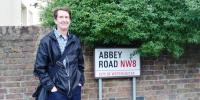
For a lot of people my age, you discovered that music was really important when you discovered The Beatles. Everything about them at the time was fresh, exciting, positive and full of energy. From the songs to the records to the hair, the suits, the boots, the wit, the slang…it couldn’t all have been preconceived and then just conjured up by some smart marketing people. There was talent and there was maybe some luck, but The Beatles were the right thing at the right moment.
Most of the records that The Beatles recorded were done at just one recording studio, Abbey Road Studios in London. That is ground zero for fans of Beatles’ records. The studio still stands today and is still in constant use. And on July 4, 2019, Gail and I, along with nearly a dozen friends, went to our musical mecca. We booked a ten-hour session in the room, Studio 2; the room where the magic happened.
We chose four original songs plus two songs we didn’t write, and got to work at 10AM to have a go at recording those songs. Our session was all over by 8PM, so if you’ve spent much time recording songs in a studio, you’ll understand our schedule was tight. Gail and I flew out from YLW, Kelowna International Airport, on Monday, July 1st, in the early afternoon. We flew to Vancouver, and then non-stop to Gatwick Airport, arriving just after 10AM on Tuesday morning, July 2. We took the Gatwick Express train to Victoria station, and then a taxi to our flat in Notting Hill, near Portobello Road.
Once we had unpacked we went for a walk around our neighbourhood.
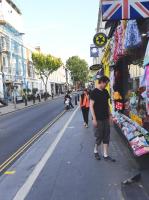
We were so excited to be in London. The weather was perfect for walking around, and we loved all the old architecture, from the houses to the churches and the quaint little shops. We picked up a few groceries, mostly so we could make some breakfast and, of course, make coffee.

The next morning, Wednesday, July 3rd, we walked over to Abbey Road Studios. It took nearly an hour, and we marveled along the way at the architecture (as we did every day in London). At Abbey Road, we met up with Stu and Teri MacDonald from Vancouver. We visited Abbey Road’s gift shop, then walked over to the St. John’s Wood underground station. A helpful attendant at the station assisted me and Gail to get our Oyster cards loaded up for riding public transit. We rode down to the Tower of London, and along the way Stu explained the tube maps on the trains and how it all worked. It’s brilliantly simple.

When we surfaced behind the Tower of London, we walked over the Tower Bridge, where we met up with Peter Leung and Smoky Senechal for lunch. We went to a place called Vapiano (there are a few of them around London). After lunch, Gail and I headed back to the train, and I was already feeling confident that we could navigate back to Notting Hill with no problem. In fact, I was feeling so confident, that I decided we could take the tube to St. John’s Wood station the next day for our day in the studio. I’ve got to say Google maps works great for getting around London. I had downloaded the often-recommended app Visit London, but with Google maps, I always had good transit info.
We had decided to meet up at a quarter to nine. The studio had invited us to come in at 9 to start the session proper at 10. It only took us about 25 minutes in all to go from our flat at 13 Pembridge to the St. John’s Wood station. Gail grabbed a coffee to go there at the Helter Skelter kiosk. We ran into Hermann Fruhm (the lone pianist in our entourage) there, and together walked the few blocks down to the famous crosswalk and then over to the gate at the studio entrance. We hung around until the whole gang had arrived, stopped for a picture on the front steps, then in we went.
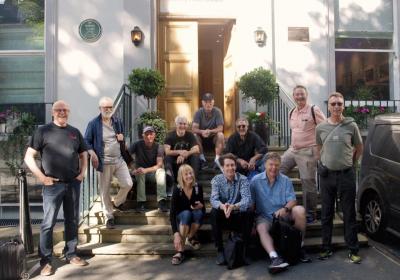
POSTED ON
Abbey Road Part 2, the session begins
July 4, 2019. 9AM.
We came in the front doors to a reception desk, and from there we crowded into a little waiting area. Before long, we were ushered through, past Studio 1 and down some stairs. We entered Studio 2 coming through double doors that bisect two isolation rooms. And there it was, the big room. The staff had already been very busy preparing for our session start time at 10AM. They were un-boxing brand new Roland M-48 monitor mixers. These were going to be used so we could individually dial in the headphone mixes that we wanted. Brilliant.
A Ludwig drum kit was already set up, surrounded by mics. The three drummers, Dave Hill, Chris Carroll and Rick Clark, took it all in for a moment, then one of them walked around behind the kit and stomped on the kick pedal. A very satisfying thump filled the air, and we all looked at each other with “this is going to be good” grins on our faces. The drummers had an assortment of cymbals to pick through to decide which ones they wanted to mount on the stands for the session .
While they got busy with that delightful chore, the guitarists went on the other side of the tall drum gobo and saw four amps, each one in its own little mini office cubicle. I called this the amp farm. Each amp (two small Fenders, a Vox and a Marshall) was mic’d and ready to go with large condensers mics in place.
Next up, we moved further into the room to check out the guitars for the session. We had rented all the instruments from Abbey Road, since no one trusted an airline with their own instruments. There was a Gibson Songwriter Deluxe acoustic, a pale blue Fender Strat, a Gibson Les Paul, a Fender Telecaster, a Gibson ES-335 and a Fender Precision bass. There was also a Rickenbacker 12-string and a box of percussion goodies that had been arranged from a music shop. After passing them around, Dan got the Tele, I got the Strat, Rob got the Les Paul and Tony took the ES-335. I plugged the Strat into the Marshall, Tony plugged into the Vox, Rob matched up the Les Paul with the Fender Deluxe and Dan put the Tele into the Fender Princeton.
Pianos were scattered around the room, including a Steinway upright that was the very piano the Beatles used on Lady Madonna and other hits. But hey, no pressure, right? Hermann was actually going to use the Yamaha grand that was parked in the larger isolation booth. With instruments all sorted we headed up the staircase that connects the live room to the control room.
Our Engineer for the day was Chris Bolster. He met the important criteria for our session; patience and a sense of humour. But seriously, Chris was fabulous for our hectic and ambitious schedule. His list of credits is, of course, stellar but I guess he drew the short straw and ended up working with us. He nudged the session along all day and worked his tail off for us. We are so grateful for his work. Chris was ably assisted by Senior Recordist Matt Jones, managing Pro Tools, who also put in a long day. As you might expect, everyone and everything at Abbey Road was so professional, and we were treated like valued clients.
Our plan was to record six songs. Engineer Chris Bolster wisely suggested that with three drummers on hand (two songs each), we record each drummer’s songs in a row, so that we wouldn’t be constantly fiddling with the kit. We had previously planned to kick off the session with a cover song, the Beatles’ I Saw Her Standing There. I had suggested this song to the group, and we would do it in a slow old time country feel. My thought was that we’d be running on a combination of jet lag and adrenaline, so something easy and low stakes to kick off would let us all settle in. Also, it seemed kind of fitting to me to kick off with a Beatles song in recognition of where we were and why we wanted to be there in the first place, and also to NOT try and do it like the Beatles did, because you know, like we’re going to do it better? So I Saw Her Standing There was it, and that put Chris Carroll on the drums. I was in the smaller iso booth to sing the song, and Hermann Fruhm and Bill Clark were in the bigger booth, on piano and acoustic guitar, respectively. The other guitarists sat in a semi-circle facing the drums, with their amps tucked behind the drums. Gail Hourigan was on the Precision bass, direct to the console. We counted in and started recording our first take at Abbey Road.
Sat 1 Jul 2017
Build Your Own Stratele
I have a Squier Tele, a Classic Vibe. I’ve always like Tele’s but my Strats have spoiled me and I wish Tele’s came with a forearm cut. What to do? I thought about modifying the Squier body, and then I thought about replacing the body with a Warmoth Tele body with a forearm cut, since I was pleased with the Warmoth body for my old 1980 Strat. And then I thought what about the comfort of a Strat with a Tele twang? Yes, Warmoth make that. And then what if I ordered a neck? I’d be on my way to a whole new guitar. Things can sure get out of hand quickly, can’t they?
After four coats of applying tung oil by hand it looks like this: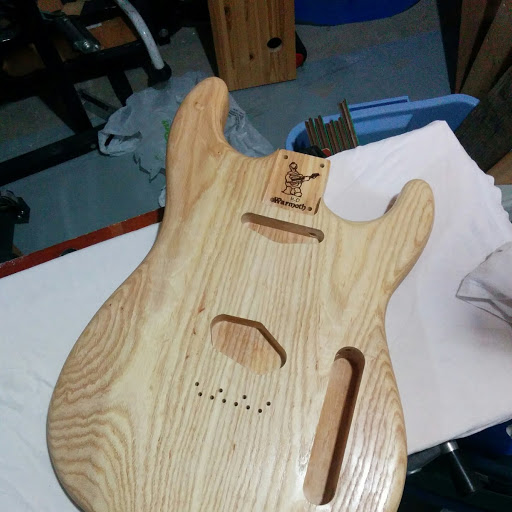 String ferrules installed, that’s a walnut stripe on the back of the neck.
String ferrules installed, that’s a walnut stripe on the back of the neck.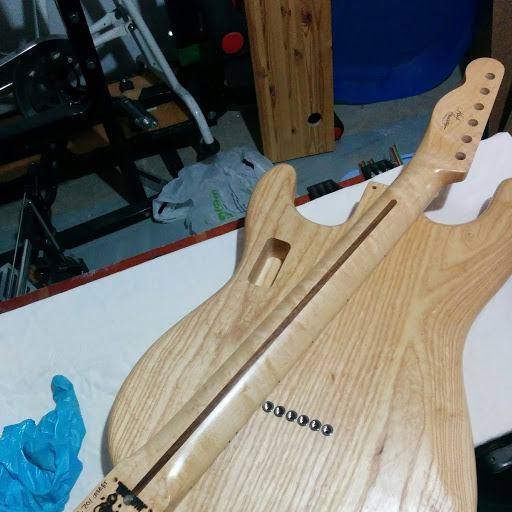
Starting to get it wired.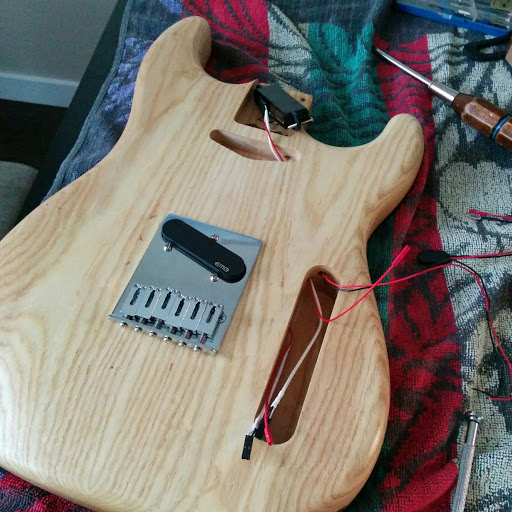
All the EMG solderless wiring done, then just snip off the battery clip wires and solder them both to the battery box.
And here it is all assembled and set up:
VIDEO: See and hear the Stratele with EMG T System pickups. More tech details, too, in case you’re curious.
Thu 4 May 2017
Kenny Aronoff
I recently had the pleasure of meeting Kenny Aronoff and attending his Tama drum workshop. Kenny is one of my favourite drummers. Kenny had lots of great stories about his career, from seeing the Beatles on Ed Sullivan all the way through to where he’s at today. He offered up a 7-step plan for success in music, and in life. He had stories and anecdotes from his personal experience to illustrate each one. I won’t recount each one here, but I’ll share a quick rundown of what he had to say.
1. Discipline
He talked a lot about practising 8 hours a day. It’s a recurring theme for him.
2. Hard Work. Show up, be prepared, know your stuff.
3. Create a plan that you execute. Don’t take no for an answer, find a way around obstacles, keep pushing forward. Lots of stories to illustrate what he means.
4. Team Communication Skills. Get everyone working together, be a problem solver.
5. RPS. Repetition is Preparation for Success. (see #1 and #2)
6. Healthy Life is a Wealthy Life. Kenny’s recipe for health, in this order, is
– weight training
– cardio
– stretching
– diet (mostly what you DON’T eat, like sugar and white flour)
– supplements (take your vitamins)
– water (drink lots)
– sleep
– meditation
7. Stay focused and relevant. The music biz changes, you better too. Don’t waste time.
And he asked what is the #1 purpose of a drummer? Kenny’s answer: get the song on the radio, make it #1.
If you get a chance to catch a Kenny Aronoff workshop, don’t miss it, even if you’re not a drummer. Oh, and bring ear plugs because they don’t call him the hardest hitting man in show business for nothing!
Fri 8 Jan 2016
Ash or Alder for a Strat body? Does it really Matter?
I used to think that the wood used for the body of a solid body electric guitar didn’t really matter. Then I swapped out the extremely heavy ash body on my 1980 Strat for a new lightweight (3 lbs 14 oz) alder body, keeping everything else the same (same neck, electronics, bridge, etc.). Yes, it makes a big difference. Due to the quality of my video camera’s audio, I don’t think the difference is as apparent on the video as it is to me when I play the guitar. It used to sound much darker, without the typical Strat snap and sparkle. The alder body reveals a glassy quality to the pickups tone that I never heard before. So I am now definitely convinced that the wood matters!
Wed 17 Jun 2015
Hawai’i Songwriting Festival
Last week I was on the big island of Hawai’i for the first Hawai’i Songwriting Festival. I attended sessions with some incredible songwriters: Sue Ennis, Gary Burr, Georgia Middleman, Jason Blume , Brett James, Big Al Anderson, Glen Phillips , Hookman Marlin Bonds, and Adam Zelkind. Talk about inspiration…and information. Also had a great chat over lunch with Michael Laskow, the founder of Taxi. I enjoyed speed mentoring sessions with music supervisor Beth Amy Rosenblatt, and Marmoset’s Ryan Wines (see Ryan’s TED talk here).
Thanks for the Brotman family who were everywhere at once keeping things moving along. The location for the conference was stunning, at the Hapuna Prince. Wow!

Wed 3 Dec 2014
Suhr pickups
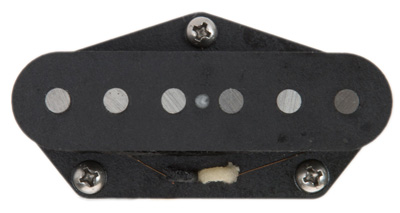
Here’s a video post to hear John Suhr talking about his pickups and amps: Factory Tour Part 5. The reason I’m posting this is that I just swapped out the pickups on my Squier Classic Vibe Telecaster for a set of Suhr Classic T Tele pickups.
I am very pleased with the results. I got to try the guitar out last Saturday night at a gig. It’s very hard to describe the difference in sound, but I”ll try anyway. The original Squier pickups are very in-your-face. They deliver a nice tubby fat sound on the neck pickup with a lot of bottom and a bright snappy sound at the bridge. The Suhr pickups are more subtle; in a way the sound is closer to my Robert Cray Strat, and that’s a good thing. The Cray Strat is a great gigging guitar because it’s comfortable, easy to play, and has enough sounds to fit any situation. The Tele was much tougher finding the right level in the mix on stage with it’s all-or-nothing take-no-prisoners pickups, and now with the Suhr’s it plays better with others.
I found the middle position great for rhythm parts, bright but not shrill, easy to control dynamics with picking. The front pickup is not as bold as the stock pickup, but again has a very useful frequency response and both Suhr pickups are nicely balanced from treble to bass strings. I had also considered Fender pickups, like the Vintage Noiseless or the Twisted Tele. Fender offer a huge selection of Tele pickups, but after watching the Suhr factory tour video and playing the Suhr guitars we have in stock at Wentworth Music I thought I’d give them a try and I’m glad I did.
Mon 8 Sep 2014
Richard Thompson
Here’s an interesting interview with Richard Thompson and featuring some great picking.
Introducing: Gail and Karl
Band gigs have not been as frequent lately, mostly because we refuse to work for just about nothing I guess, and that’s where the economy seems to be driving prices for bands around these parts. Gail and I have been doing more gigs as a duo, so we fired up a new website. It’s super simple, but I like it. Dive in at GailandKarl.com
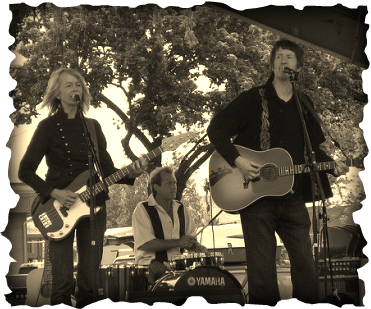
Tue 28 Jan 2014
Long name, but check it out
Well this is really interesting. Fender keep finding ways to keep their product offerings fresh, and they’ve had a lot more hits than misses. The Pawnshop Series is an excellent case in point. Recently, they’ve introduced a new model that I must confess has me really excited. The Fender Pawn Shop ’70s Stratocaster Deluxe is a great idea. It’s a Strat hardtail body (I own two hardtail Strats, a 1980 model and a 2006 Robert Cray model), with a Tele front pickup (awesome!) and a sweet, bright humbucker. Check and check. It’s got a maple neck, bullet truss rod access, and 22 frets. It comes in 3 colours, and they’re all cool in their way.
I’ve played one briefly, and it’s nearly perfect. I really want one. If/when I get one, I will swap out the bridge saddles because I really like the Graph Tech saddles. I first tried them when I literally wore out the original saddles on my 1980 Strat, and I loved them. I put a set on the Robert Cray and those were a big improvement for me. The only other thing on this Pawn Shop model might be the Jazz bass knobs – I’m just not sure about them. They don’t look that cool to me. What do you think?
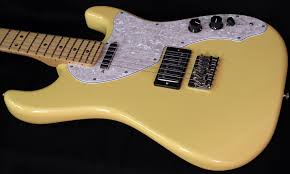
Meanwhile, over at Gibson, they’ve introduced a really affordable US-made Les Paul Junior (or LPJ). Tempting, but if I go by my gut, the 70s Pawn Shop Strat Deluxe is where my money would go.
Sun 20 Oct 2013
Flower By the Road
Get your hillbilly on.
Sun 20 Oct 2013
A new song
Here’s an old school Motown style R’n’B number called Before We Say Hello. Written by me and David Cavan Fraser.
https://youtube.com/watch?v=l67e8XJl05A%3Flist%3DUUJWdtFk2mNDf8Z1A-Rbn8tQ
Sun 20 Oct 2013
Donald Ray Johnson
I caught this great set by Donald Ray Johnson at Wine-ohs. Great stuff, guys!
https://youtube.com/watch?v=yTSv22a7aAM%3Flist%3DUUJWdtFk2mNDf8Z1A-Rbn8tQ
Thu 10 Oct 2013
Back from Breakout West
I’m back from Breakout West, and there’s so much follow up work to do, it’s great! It was so good to meet Music Supervisors Connie Farr, Michael Perlmutter, Natasha Duprey, Richard Glasser, Andrea von Foerster, Samuel Diaz and Aminé Ramer. Thank you all for your time and participation.
The keynote interview with Michael Chugge was great, but I didn’t get a chance to check out the rest of the National Music Centre – next time, Calgary.
Sat 28 Sep 2013
Breakout West 2013
I’ll be there! Looking forward to meeting lots of people at Breakout West in Calgary, especially music supervisors. I’ll be armed with business cards, meta data-rich CD’s with clear contact info on the labels and a focus on finding out how I can be of service to make it easy for you to find and license some great music!
Thu 5 Jul 2012
Taking music into space with Chris Hadfield
Astronaut Chris Hadfield talks about playing guitar in space.
http://www.youtube.com/embed/gWTndmDHZQc
How I thought internet radio could work in 2007
The Web, the radio and the record companies
or
How things might work out so musicians can make a living (from a Canadian’s perspective)
originally written by Karl Hourigan November 8, 2005
I’m writing this little train wreck of an essay in the hope that I can, at best, spur some discussion and inspire our imaginations as to what may come to pass in the not so distant future. At worst it’ll just waste your time to read it.
Every day (literally) I come across articles about MP3 in one form or another. We all know the current challenges with this digital format, and many of the conversations sound very familiar to anyone who remembers the introduction of the cassette tape, or if you’re REALLY OLD, the invention of recorded sound. The RIAA’s credibility in this regard has been further weakened by two fairly recent events: 1. major record companies in the US have just lost a court case and been fined for essentially colluding to gouge retail customers 2. major artists and industry observers have spoken out in an articulate fashion about just what a sad deal most record companies give their artists.
It has been said that “digital information wants to be free” (numerous sources). It has also been said that “music wants to be free” (Travis). OK, but everyone wants to get paid. The trick now is to find a model that accepts digital delivery AND generates an exchange of dollars.
Anybody with a computer and an internet connection can be their own radio station on the internet. Unregulated, uncensored, unlicensed and unaccountable–in other words it’s a kind of like a vision of nirvana for anyone too young to really understand what mortgage payments look like. This vision is currently a songwriter’s nightmare.
I’d like to suggest a different dream that brings together a number of existing or plausible technologies. The players in this little drama are:
Streaming media
Wireless internet
Internet appliances
Central storage
and the usual suspects who control, administer, own or profit from copyrights.
The potential of internet radio is waiting to be realized. First, let’s try to describe a business model that would appeal to the end user, then explore the ramifications of that model on the vested interests (artists, publishers, record labels, radio, etc.). Finally, let’s take a look at some of the challenges that can prevent this from working out.
The End User Experience
Internet radio is readily available now on a typical home computer. As broadband quickly becomes more ubiquitous, and more and more homes have internet-capable computers, internet radio will flourish. The advantages of internet radio include an unprecedented wealth of potential programming, catering to every possible interest group. Like traditional broadcast radio, it’s free to the listener (except that we’re paying for an ISP).
What’s needed is an internet radio appliance that can use a simple familiar interface, but offers much more than conventional radio. Let’s imagine such a device in a hypothetical setting:
The internet radio is mounted under the upper cabinets in the kitchen. It plays music in stereo, or even 5.1 surround sound, at higher than CD quality. “Stations” can be chosen in a number of ways—styles of music or content (classical, rap, punk, news, talk, etc.), artists or groups of artists (e.g. Beatles or Beatles solo), place of origin (Detroit, Iraq, Russia, etc.), random, traditional broadcasters (e.g. CBC programming) and so on. Of course our radio can remember presets and preferences. It can automatically add new stations by category as they come online.
So far so good, but here’s where the interactivity of internet radio takes off from traditional radio. Let’s say you’re listening to a track by an artist you’ve never heard before. You can check the read out on your internet radio (let’s NOT refer to it as iRadio!) and instruct your radio to play more songs by that artist or from that album, or in that style (e.g. “choose more music featuring the sitar”). In the future, this could be voice-activated so you wouldn’t even have to stop chopping vegetables in the kitchen! You could return to the previous programming at any time.
But what if you listened to this new artist and decided you wanted to “bookmark” the song or artist for future listening? No problem. And here’s where we possibly return to the pop age of the “single”. Through the ISP connected to your internet radio, your subscription includes a certain number of “bookmarks” every month, say 50. If you want more than that, you are charged a very nominal fee. Your ISP account has a counter that tracks your “bookmarks”. Of course with internet radio, if you remember the name of the song or the artist, there may be a dedicated “station” where you can hear that artist anytime you want. But once you’ve bookmarked a song, you can go straight to it on demand. But wait, there’s more—through your internet radio’s FireWire connector, you can download your bookmarks and output them in any digital format you want, from mp3 to CD. Now you can take your bookmarked favourites with you. Later, when cars have internet radios, you can log on and access your bookmarked music in your car or wherever you have access to an internet radio device. The bookmarked material is not stored on the internet radio, it is stored by the provider (e.g. copyright holder, publisher) and served through your ISP. This also ties into wireless internet radios for accessing your “bookmarked” music.
The ISP and other music-on-demand sites have logged every “bookmark” of every customer so that should be no problem to assign royalties to the correct parties. The customer never has to buy another CD if they don’t want to, but they can access their music library from any internet appliance (like say, your wireless internet watch). They’re paying for music, every recording is tracked, and everybody can get a little tiny piece of the action. ISP’s could offer to sell custom one-off enhanced CD compilations too, with videos, lyrics etc., just as an additional revenue stream.
The Vested Interests
If the internet radio delivers inexpensive music that you can try before you buy, a lot more music will be sold (how much music would you buy at pennies a song?). This may have a negative effect on the multi-million sellers that are sold on marketing hype, but could provide some viable income to a wider spectrum of artists.
Record labels move their business from pressing CD’s to an emphasis on marketing to get their artists heard and subsequently “bookmarked”. Publishers get a way to generate income from a greater selection of their portfolio (the long tail effect). During this phase, traditional radio and the income it generates is still ongoing.
With digital delivery through ISP’s, it should be realistic to mark and track every tune played. The ISP’s would pay performing rights societies (micro-payments) to deliver such content, just as radio stations do today.
Artists and their labels could still release CD’s, but internet radio would actually deliver higher audio quality (why settle for 44.1kHz 16-bit audio any more?). Of course, individuals could still be their own internet radio stations, but they would be challenged to support the interactivity of the dedicated internet radio appliance. Given the consolidation of publishing, production, artist and repertoire management, plus broadcasting and distribution AND manufacturing prevalent in today’s market (e.g. Sony), the major record labels are in a position to profit from such a change in the way music is delivered—manufacturing internet radios, reducing losses to piracy, activating income from more of their catalogue, etc..
“Bookmarks” could also be arranged by the subscriber into any categories they wanted (e.g. Summer Road Trip 1). Subscriptions could allow for multiple users, as in a family.
Hey, but what about…
CRTC and other broadcast regulatory bodies would be in a very difficult position to regulate internet radio. The attraction to the end user is all about choice, convenience and low cost. CanCon would suffer, for example, but there is nothing today to prevent me from listening to radio from around the world via my computer. I can hear a range of uncensored music and views. Pandora’s box has been opened, and in free democracies, we are reluctant to shut that lid. We prefer to choose not to listen if we don’t like what we hear. The difficulty for artists is that under the present situation, they are not being paid for current internet usage of their material. But if record companies insist on trying to collect pressed record type prices for internet delivery, the artists will ultimately lose out. ISP’s and record companies must realize the potential of micro-payments as a viable business model in an internet radio environment.
Another sticking point would be labels or artists not participating. The attraction would be to have any and every thing available. ISP’s could make licensing agreements with record labels. Given the current consolidation in that market, this is a good time to pursue agreements that would give ISPs access to most titles. New services would spring up (or old services would adapt) to help independent artists have their music featured on “independent” channels. More radically, a change in copyright laws could allow anyone to “broadcast” anything on the internet provided they were licensed to do so, meaning that they were following rules for tracking and paying royalties on distributed materials.
Scenario – the view from Sony
So you’re Sony. And you want to plug your artists and publishing. But you realize that internet radio restricted to only your catalogue, as big as it is, is not enough. So you license your entire catalogue to sub-stations, who offer up whatever playlists they want to, which can include Sony stuff. Plus Sony still gets paid back by the ISP’s who serve up their stuff regardless of the “station” that the end user has bookmarked the song from.
I think historically any time technology has introduced new ways to distribute music (read expand the potential audience), after the initial shockwaves and catastrophes, new business models emerge and new opportunities are created. Don’t get hung up on mp3’s. They’re not the last word. They’re just the first shot in this latest battle of the digital revolution. Record companies and radio stations need to get right in there with wireless internet technology, because they already understand many of the components that can make that business model work.
Sun 13 May 2007
Music’s Future Digital and Online: Experts
Um, like I’ve been saying…
Music’s Future Digital and Online: Experts
Wed 16 May 2007
Aging – what if life counted down, like in hockey?
When you’re watching a soccer game (football to some), the clock ticks up to note how much time has passed. The actual time the game will end is a little fuzzy, ultimately up to the referee to decide. I think a lot of us live our lives that way. We know it’s going to end, but not sure when, exactly, so we kind of run around, trying to work with others towards a common goal.
In the game of ice hockey, the clock ticks down to show you how much time is left. Hence, the familiar announcement “last minute of play…”, which usually spurs the players into one last effort to do whatever it is they can to win the game. So I got to thinking, what if my life was timed that way. If I was given the rules of the game early on, say, “you have 65 years, 3 months, and 5 days to live, and there will be no overtime, no scoring shoot outs. You get to play regulation time only”, what would I have done differently with the time I’ve “played” so far? What would my “game strategy” have been? Would I play defensively, try to stay out of the penalty box? Or maybe offensively, driving to score on every shift? Maybe casually, like hey, it’s just a game?
Of course the game strategy we employ as adults is very much the result of our upbringing. Were we raised in an atmosphere of conservative pragmatism, dreamy optimism, or a confused mix of both? Was it OK to be ourselves growing up? Is it OK to be ourselves now?
Well, thinking backwards from the end is something some of us can do, and those lives give rise to phrases like “living for today”, “live each day as if it were your last”, and so on. If I were living today as if it were my last, what would I do today? Party like it’s 1999? Or get the Dalai Lama on the phone for some last minute advice?
So guys, we’re in the game, the clock is ticking down, and if our game strategy hasn’t made us feel like winners so far, maybe we need to call a time out, have a chat with our peers and the coach (hmmm, maybe finding a coach is a good idea at this point), and figure out how we’re going to play out the remaining time. Because wouldn’t we really prefer to have our victory in the bag before the clock runs out?